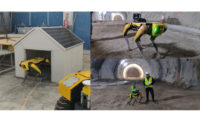Concrete technology is not an easy business to break into. There have been many attempts in recent years to "green" the concrete business, from cements that fix CO2 during the curing process to industry attempts to increase the use of fly ash in concrete. But while new companies have come and gone, Parsippany, N.J.-based Solidia Technologies thinks it's onto something new.
The venture-capital-backed firm recently signed a partnership agreement with France-based concrete giant Lafarge and is now working to bring its CO2-cured cement to market. Lafarge will work with Solidia on demonstrations of commercial-scale installations of concrete made with Solidia cement in 2014.
Solodia's cement requires the injection of CO2 gas during curing; it is fired at a lower kiln temperature, and, most important, it can be used on existing cement equipment without major modifications.
"We are bringing to market a reformulation of portland cement that allows it to be manufactured with a much lower carbon footprint," says Nick DeCristofaro, chief technology officer at Solidia. "Our formulation uses less limestone, and while portland cement is fired at about 1,500 C, Solidia cement needs only about 1,200 C."
Solidia cement isn't produced through a portland-cement-style calcium hydration reaction, in which water acts as a catalyst for calcium to form bonds. Rather, it uses CO2 to catalyze the reaction, resulting in a calcium carbonate. "It's making a carbonate instead of a hydrate, and carbonates are very stable," says Dr. Richard Riman, distinguished professor of Rutgers University's Dept. of Materials Science and Engineering and the co-founder and chief scientist of Solidia. Riman co-invented, in 2007, what became the Solidia cement with his then-postdoctoral student Vahit Atakan, who now serves as Solidia's director of research and development. "We don't form the dicalcium silicate or tricalcium silicate bonds like in portland cement," says Riman. "The reaction with the CO2 happens with monocalcium silicate, which does not react with water. Dicalcium silicate and tricalcium silicate will react with CO2 and form carbonate, but you don't get the same beneficial crystal reaction as the monocalcium silicate."
Riman says that while the industry has experimented for decades with carbonate reactions on dicalcium and tricalcium silicates, there hasn't been an attempt to use monocalcium silicate. "Water is present, but it just gets us a higher particle density and allows us to get an electric charge so the reaction happens."
‘It’s an Achilles’ Heel’
Riman admits there are still unresolved problems for Solidia cement's performance in reinforced-concrete applications. Portland cement has a fairly high pH value, and this reduces the chance of carbonation sites forming along steel in contact with the concrete, such as rebar. But concrete made from Solidia's cement has a lower pH than portland cement, and this can contribute to the early oxidation of rebar. "Now that pH—it's an Achilles' heel for us right now," says Riman. "We are working on solutions to these problems, not a temporary solution, but a permanent fix. We believe there will be a stable way to deal with it."
Oxidation in low-pH concrete systems has been a perennial stumbling block for new cement technologies, says Steve Kosmatka, staff vice president of research and technical services for the Portland Cement Association (PCA). "You go into a system that uses CO2, a low-pH system, but how does it protect the steel? You see that in old buildings, where, if the steel is exposed to air, it corrodes. There are safety concerns with new technologies."
Riman admits this issue will limit initial applications for concrete made with Solidia cement. "We're not going to be telling people to put rebar in this material until we have a solution that we know works. Plenty of products don't require rebar, and we're going there first."
According to DeCristofaro, concrete currently made with Solidia's cement results in sequestered CO2 comprising about 5% of the mass. "We're very focused on lowering the carbon footprint, from the sequestration of CO2 to the reduced fuel usage in lower kiln temperatures," he says. Solidia currently has a creative research-and-development agreement (CRADA) with the U.S. Dept. of Transportation, and the Federal Highway Administration is testing concrete made with Solidia cement for use in curbs, barriers and other road features.
While there is interest in new cement and concrete technologies, Kosmatka of PCA says there are many hurdles to clear before they gain wide acceptance. "The engineering and construction industry is fairly conservative, and there are many unanswered questions about new technologies. It takes more than saying it can gain strength comparable to traditional concrete. Most people equate the word 'concrete' to long-term strength and durability. Many of these new products have yet to demonstrate these properties."




